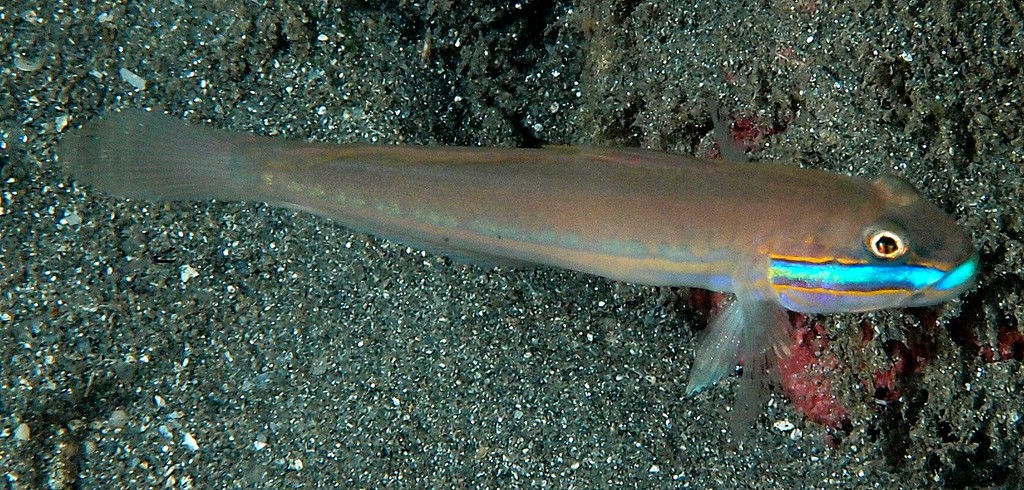VALENCIENNEA RANDALLI - (HOESE & LARSON, 1994)
Actinopterygii (Class) > Perciformes (Order) > Gobiidae (Family) > Gobiinae (Subfamily) > Valenciennea (Genus)
Green-band sleeper-goby, Greenband glider goby, Greenband glidergoby, Greenband goby,
Description
Dorsal spines (total): 6 - 7; Dorsal soft rays (total): 16-18; Anal spines: 1; Anal soft rays: 16 - 18. Characterized by pale grey body color with red and blue-edged blue-green stripe below eye; faint orange stripe along lower side; third dorsal spine longest and prolonged in adult; rhomboid caudal fin, longer than head; longitudinal scale series 76-81; ctenoid body scales, becoming cycloid below first dorsal fin; head or midline of nape without scales; side of nape with scales extending forward to above middle of operculum; fully scaled pectoral fin base and prepelvic area in adult; depth of body 5.0-5.9 in SL. Max length : 16.0 cm SL. depth range 8 - 30 m.
Etymology
Valenciennea: From Achille Valenciennes 1794-1865; he worked with Duméril, Cuvier and Lacepède since 1815; malacologist, author of a "Histoire naturelle des poissons"
randalli: The name of this species randalli is in honour of the esteemed ichthyologist John E. "Jack" Randall.
Distribution
Western Pacific: Ryukyu Islands, Philippines, Solomon Islands, Malaysia, Palau, Indonesia and the Great Barrier Reef. Reported from New Caledonia.
Biology
Inhabits coastal estuaries and muddy slopes adjacent to algal reef to about 30 meters depth. Solitary. Found in mud or fine silty sand bottoms. usually in the vicinity of its burrow.
Green-band sleeper-goby, Greenband glider goby, Greenband glidergoby, Greenband goby,
Description
Dorsal spines (total): 6 - 7; Dorsal soft rays (total): 16-18; Anal spines: 1; Anal soft rays: 16 - 18. Characterized by pale grey body color with red and blue-edged blue-green stripe below eye; faint orange stripe along lower side; third dorsal spine longest and prolonged in adult; rhomboid caudal fin, longer than head; longitudinal scale series 76-81; ctenoid body scales, becoming cycloid below first dorsal fin; head or midline of nape without scales; side of nape with scales extending forward to above middle of operculum; fully scaled pectoral fin base and prepelvic area in adult; depth of body 5.0-5.9 in SL. Max length : 16.0 cm SL. depth range 8 - 30 m.
Etymology
Valenciennea: From Achille Valenciennes 1794-1865; he worked with Duméril, Cuvier and Lacepède since 1815; malacologist, author of a "Histoire naturelle des poissons"
randalli: The name of this species randalli is in honour of the esteemed ichthyologist John E. "Jack" Randall.
Distribution
Western Pacific: Ryukyu Islands, Philippines, Solomon Islands, Malaysia, Palau, Indonesia and the Great Barrier Reef. Reported from New Caledonia.
Biology
Inhabits coastal estuaries and muddy slopes adjacent to algal reef to about 30 meters depth. Solitary. Found in mud or fine silty sand bottoms. usually in the vicinity of its burrow.
